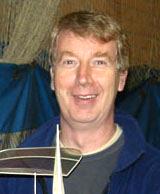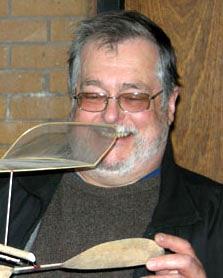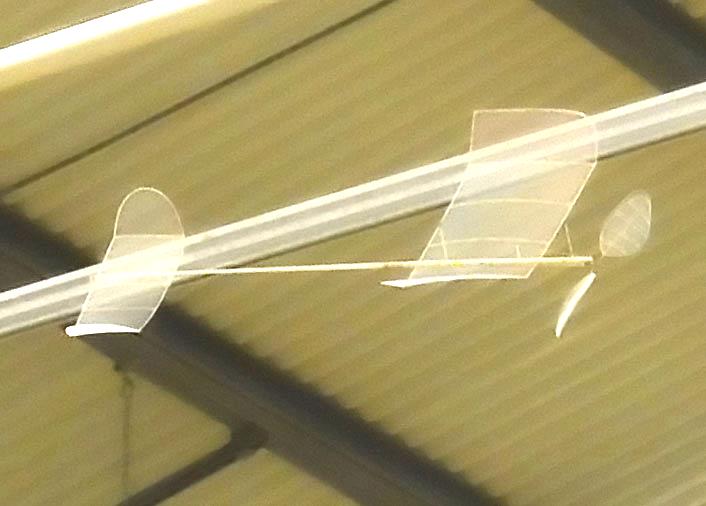





Copyright © 2017 by "Tom Tomlinson" " All Rights reserved

The price of hiring a good hall is high, but we usually manage to just about balance the income/ costs, providing we get support from regulars. Flying charges vary according to numbers attending. Spectators and juniors are free.
We were in unanimous agreement about retaining the style of the meeting as primarily being for indoor freeflight, but that we would welcome micro radio, if flown thoughtfully with respect to fragile freeflight models. Models should be restricted to a max wingspan 24" max weight 28 grams).




Anyone who is a model aircraft addict is welcome
Our meetings have their own characteristics. With the emergence of 'ready-to-fly' radio models, lightweight freeflight models have been increasingly pushed out of flying sites to the point of near extinction. We aim to address this by keeping the balance between fragile freeflight models and radio models. This can be achieved by limiting radio models to the 'micro' category. Shockflyers, helicopters and radio models with a wingspan of over 20 inches create so much turbulence, that even if the pilot is competent, it makes the air unflyable for lightweight freeflight models. A 1.2 - 3gm model is thrown around by people just walking too fast... Experience at other sites shows that the 'slot' sytem does not work for anything that can be classified as lightweight, so we have abandoned it. We also ask that common sense is used about keeping the size and speed of freeflight models to something appropriate in relation to the style of the meetings.
We try to operate on an informal/ inclusive/ friendly basis, but reserve the right to ask people to refrain from flying unsuitable models.
Our meetings and meetings at the Manchester Velodrome (in danger at present) are literally the last foothold that freeflight competition and lightweight flyers have in the North West of England, so we hold friendly competitions at the meetings and the number of flyers participating is growing, as they see what fun we are having. Younger flyers are also joining in, which is really encouraging.
Don't worry about looking foolish when you start comp flying. We have all been there and have had help from those who have more experience. The important thing is to join in and fly against yourself until you catch up. Your flying WILL improve! Don't be afraid to ask for advice! Plenty of help is available if you fancy a go! Start with one of the easier classes and build from there! If you would like advice/ help, choose a good moment to talk to us at NORWIND or mail us via the 'contact' page.
As radio flyers have many venues, we ask that you respect the fact that we are trying to keep alive the very form of modelling which laid the foundation for the indoor movement. With a little bit of common sense, both radio and freeflight modellers get along well and a great time is had by all. We all have fun because the majority fly thoughtfully.
Our meetings have their own characteristics. With the emergence of 'ready-to-fly' radio models, lightweight freeflight models have been increasingly pushed out of flying sites to the point of near extinction. We aim to address this by keeping the balance between fragile freeflight models and radio models. This can be achieved by limiting radio models to the 'micro' category. Shockflyers, helicopters and radio models with a wingspan of over 20 inches create so much turbulence, that even if the pilot is competent, it makes the air unflyable for lightweight freeflight models. A 1.2 - 3gm model is thrown around by people just walking too fast... Experience at other sites shows that the 'slot' sytem does not work for anything that can be classified as lightweight, so we have abandoned it. We also ask that common sense is used about keeping the size and speed of freeflight models to something appropriate in relation to the style of the meetings.
We try to operate on an informal/ inclusive/ friendly basis, but reserve the right to ask people to refrain from flying unsuitable models.
Our meetings and meetings at the Manchester Velodrome (in danger at present) are literally the last foothold that freeflight competition and lightweight flyers have in the North West of England, so we hold friendly competitions at the meetings and the number of flyers participating is growing, as they see what fun we are having. Younger flyers are also joining in, which is really encouraging.
Don't worry about looking foolish when you start comp flying. We have all been there and have had help from those who have more experience. The important thing is to join in and fly against yourself until you catch up. Your flying WILL improve! Don't be afraid to ask for advice! Plenty of help is available if you fancy a go! Start with one of the easier classes and build from there! If you would like advice/ help, choose a good moment to talk to us at NORWIND or mail us via the 'contact' page.
As radio flyers have many venues, we ask that you respect the fact that we are trying to keep alive the very form of modelling which laid the foundation for the indoor movement. With a little bit of common sense, both radio and freeflight modellers get along well and a great time is had by all. We all have fun because the majority fly thoughtfully.
THE NAME NORWIND WAS CHOSEN BY THE MEMBERS AS A TRIBUTE TO JOHN O'DONNELL (14.8.1932 - 18.4.2017) WHO WAS A MEMBER OF THE GROUP AND PROBABLY THE BEST FREE FLIGHT COMPETITOR THE UK HAS EVER HAD. JOHN RAN THE ORIGINAL NORWIND GROUP FOR MANY YEARS AND INTRODUCED MANY CURRENT MEMBERS TO INDOOR FLIGHT
Given the mix of models at our meetings, it is helpful if flyers try to be considerate. A few simple 'rules' will help this along and could keep you safe from a clout on the head by a model! :
1. PLEASE PLEASE don't stand talking or watching your model in the middle of the hall. You are preventing others from launching (and it tends to be the same culprits most of the time!). Just move to the wall area.
2. WALK SLOWLY. You can rip the wing off a lightweight model if you walk past quickly. You will also drag it into your wake if it is above or near you. If a lightweight model is flying towards you, gently move to the side only as much as you need to, in order to avoid it. This is particularly true if it is on a good comp flight, which you might ruin if you move too fast.
3. Close doors completely and open/close them slowly. An open door at either end of the hall makes the air very turbulent.
4. Look around before launching and retrieving. Check that the path of your model won't compromise others.
5. Try to observe the different ends of the hall for radio/heavier/ lightweights. This isn't always easy for lightweights, as they drift in turbulent air. We try to deal with this by using steering poles if possible.
ABOUT NORWIND
FLYING ETIQUETTE - some observations from Tom
Please feel free to come and talk to the organisers of NORWIND


Tom Crompton Dave Whitehouse
